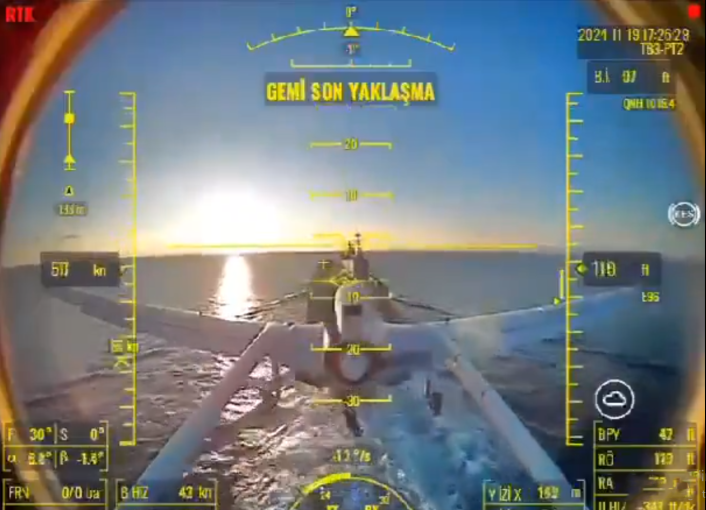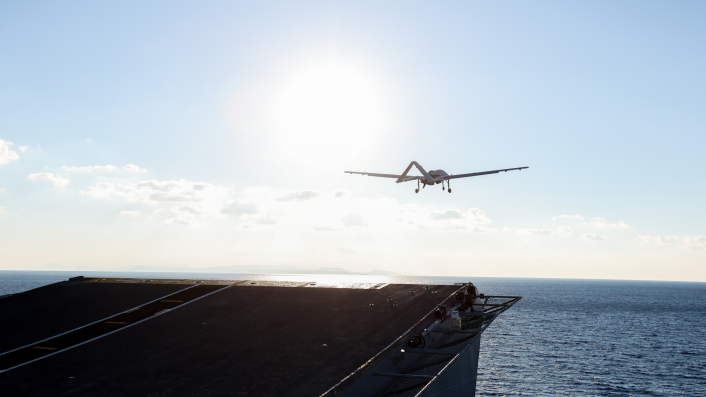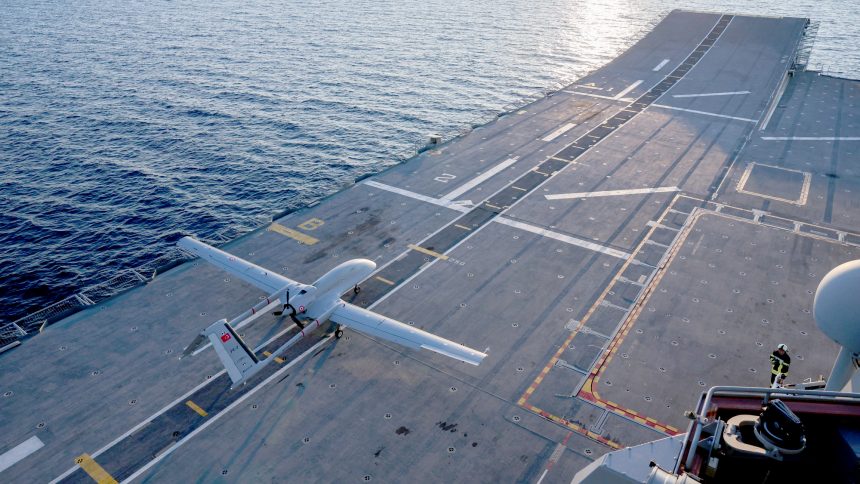The TB3’s second prototype conducted its first flight from the ship, which is expected to serve as a dedicated drone carrier, following land-based ski-jump testing. Manufacturer Baykar stated that the landing was performed autonomously.
Turkey’s Bayraktar TB3 UCAV (Unmanned Combat Aerial Vehicle), a naval version of the Bayraktar TB2 attack drone, took off and landed back on the TCG Anadolu amphibious assault ship on Nov. 19, 2024, the developer Baykar announced. Bayraktar’s chief technology officer Selçuk Bayraktar and other Turkish defense accounts said that the landing was carried out by the drone fully autonomously.
The test flight was already known to be imminent as the drone had been practicing operating from a land-based ski-jump for several months since May 2024. The amphibious assault ship is also a helicopter carrier and a dedicated UAV carrier, and has been seen carrying an earlier prototype of the Kizilelma UCAV and the TB3 in the past.
#BayraktarTB3 PT-2 🤝 TCG Anadolu ✈️🚢⚓️🚀
Dünya Havacılık Tarihinde Bir İlk!
✅ Kısa Pistli Gemiden Kalkış-İniş Testi
☁️ Toplam Uçuş Saati: 823 Saat
A groundbreaking moment in aviation history!
✅ Short-Runway Carrier Take-Off & Landing Test
☁️ Total Flight Hours: 823… pic.twitter.com/STnmuewlTK
— BAYKAR (@BaykarTech) November 19, 2024
Prior to the final flight, on Nov. 18, Bayraktar posted photos of the TB3 taking off from the ski ramp amid a sunset. The Daily Sabah said the drone has so far completed six such tests. The pusher-propeller TB3, which has foldable wings for its naval role, was previously slated to be tested and then eventually operated from the TCG Anadolu, according to Turkish reports and Bayraktar’s statements.
📍 Yer: Muğla, Aksaz – TCG ANADOLU
📅 Tarih: 19 Kasım 2024
TB3 SİHA İki Mavi’yi Bir Araya Getirdi!
En büyük donanma gemimiz TCG ANADOLU’dan kalkan TB3 Gökyüzünde süzüldü 46 dakikalık test uçuşunun ardından tekrar TCG ANADOLU’ya başarıyla indi!
İşte Detaylar:
Rampa testlerini… pic.twitter.com/UYILyjxOpB
— MaviVatan.net (@mavivatannet) November 19, 2024
The test
The prototype that flew from Anadolu was PT-2, which a video released by Baykar showed while being raised to the flight deck by its stern elevator. The drone powered up its TEI PD170 engine and took off in a STOL (Short Take-Off Landing) departure from the TCG Anadolu’s 12 degree inclined ramp, according to Turkish defense news handle MahiVatan. The test flight lasted 46 minutes.
A camera attached to the right wing shows the drone retracting its landing gear and flying in a pattern mostly around the carrier. Then, it lowers again its landing gear and begins the approach. The drone also does not appear to have the large electro-optical turret on its underside, as has been visible in other exhibition models at defense shows. Footage from the camera installed on the joint of the drone’s twin boom-mounted inverted-v tail shows the complete approach and landing sequence with various kinematic and telemetry readings.

The TB3 landed on the flight deck, with Baykar saying the maneuver was fully autonomous. The aircraft used its own braking system to stop on the 202 meter (662 feet) long flight deck, without the use of an arrestor hook.
There was a light crosswind during the landing, said another Turkish defense news handle, ‘Tr_tech’. However, the autonomous flight algorithms withstood and correctly “processed data from sensors…dominating the actuators and the PD170,” resulting in a “perfect landing.”
In a recent similar test, the Republic of Korea Navy’s Dokdo amphibious landing ship, saw a General Atomics Gray Eagle STOL unmanned aircraft flying off from in the first such test flight on Nov. 12, 2024, although its deck is even smaller, at 199 meters (653 feet). That drone was however fully operated by GA-ASI’s personnel, both from aboard the ship and the Pohang naval aviation base where it landed, without mention of autonomous operations.
The post from ‘Tr_tech’ added that another prototype, PT-1, was also used in the same test campaign. In fact, both airframes, which had successfully completed the ramp tests, took off from the Baykar Flight Training and Test Center in Keşan, and arrived at the Dalaman Airfield Command. Over the next few days, PT-1 performed “close flights” over the TCG Anadolu during day and night, ultimately passing the “approach tests.”
🔴🇹🇷Bayraktar TB3, TCG ANADOLU’dan havalandı
🔸Bayraktar TB3 SİHA, TCG ANADOLU’dan ilk kalkış ve inişi gerçekleştirdi
📎 @BaykarTech pic.twitter.com/JkxoiOaNz2
— Defence Turk (@Defence_Turk) November 19, 2024
Role in the Turkish Navy
TurDef reports that the TB3 “will mainly operate as an armed ISR [Intelligence, Surveillance and Reconnaissance] platform with an endurance of up to 21 to 36 hours, depending on the payload.” Its primary role would be to patrol around the TCG Anadolu LHD (Landing Helicopter Dock) during landing operations.
The Turkish Navy also operates U.S.-made S-70B Sea Hawk and AH-1W Super Cobra helicopters that have been on the Anadolu’s deck while sailing. As a NATO member nation, Turkey has also designed the ship to be compatible with the alliance’s equipment, as demonstrated by a U.S. Marine Corps MV-22B Osprey which landed on it on Aug. 15, 2024.
#BayraktarTB3 Otomatik İniş / Autonomous Landing
Devamı gelecek / More to come…
📍TCG ANADOLU 🇹🇷⚓️🚀 pic.twitter.com/LxbjIxvOoq
— Selçuk Bayraktar (@Selcuk) November 19, 2024
The TB3 made its maiden flight in Oct. 2023, and reports a year later said it has entered mass production, with export orders expected by early 2025. Whether there are other differences between the export version and the one tested from the TCG Anadolu, or if there is a third prototype, is not yet clear. It is also not known whether the one having entered production is a different version for the Turkish Air Force or the Army.

With a payload capacity of up to 280 kg, the TB3 can carry the MAM-series air-to-ground munitions, TOLUN SDB (Small Diameter Bomb), KEMANKEŞ 1 loitering munition, and SUNGUR air-to-air missile, in addition to an EO/IR system, TurDef added. The drone is also compatible with other sensors such as sonobuoys for ASW (Anti-Submarine Warfare) and an AESA (Active Electronically Scanned Array) radar.









